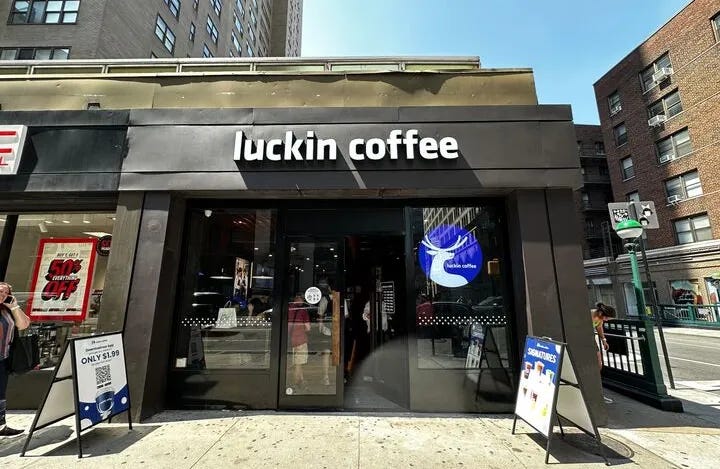Unknown Author | September 23, 2025
The Luckin Coffee Edition
On Manhattan's new, anti-Starbucks school of ruthless caffeine efficiency.
Colin here. I just checked out one of Luckin Coffee's new storefronts in Manhattan, and it feels different. They aren't optimizing for vibe: no couches for lingering or convivial atmosphere. It's steely-eyed realism about what they think will win: screens, QR codes, and a bare-bones counter where a latte materializes quickly and cheaply. It's the anti-Starbucks, and that's the point.
Luckin's strategy is about speed and cost, full stop. Founded in 2017, the brand exploded across Chinese cities with a simple formula: small, efficient locations; app-only ordering and payment; and prices undercutting Starbucks by 30–40%. Their rise was meteoric, their fall spectacular (a 2020 accounting scandal almost derailed them), and their rebound even more so. Today they have over 20,000 locations in China—far more than Starbucks.
Why is this interesting?
In China, Luckin positioned itself as a caffeine utility—just efficient delivery of something aspirational but accessible. The app did the heavy lifting, gamifying repeat purchases, locking in loyalty with discounts, and making ordering frictionless.
In Manhattan, that same model reads very differently. A $3 latte in a city where the going rate is closer to $6 grabs attention. Luckin is betting there are coffee-buying customers for whom meeting spaces and welcoming vibes don't matter: people on the go, students, the frenzy of a Manhattan day.
That's a direct challenge to Starbucks, which has spent decades defining itself as the "third place"—not home, not work, but somewhere in between. Starbucks has doubled down on this recently, investing in larger, more elaborate stores, Reserves that double as showpiece tourist attractions, and an ever-expanding menu of complicated things.
Starbucks tries to add value through experience: the reliable Wi-Fi, the ritual of ordering, the branded cup. The question becomes: have they drifted so far into experience that they're vulnerable to someone undercutting them on basics?
Then there's the other flank of third-wave coffee shops that dot New York—Blue Bottle, Stumptown, Everyman Espresso. These places compete on craft, provenance, and cultural capital. The pitch isn't efficiency, it's expertise. But as anyone currently waiting for a V60 to be painstakingly made knows, that takes time.
Luckin’s timing might be right. Inflation has made people more cost-conscious. New Yorkers have returned to commuting, making speed and convenience more valuable. For office workers who just need caffeine between meetings, a quick $3 latte starts to look rational.
Maybe Luckin has spotted a seam in the culture: a utilitarian lane where speed and cost win out over narrative and ambiance.
The U.S. coffee scene has always been a mirror of national character. The bottomless diner cup reflected abundance and openness. Starbucks reflected globalization and the craving for experience. Third wave reflected craft and discernment. Luckin reflects something else entirely: the relentless pursuit of efficiency in a city that already runs on it. (CJN)
